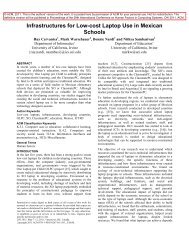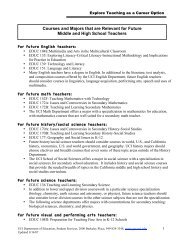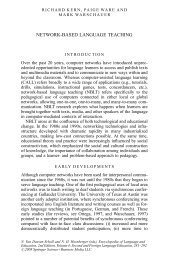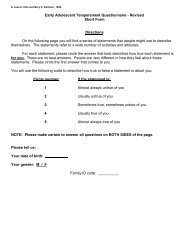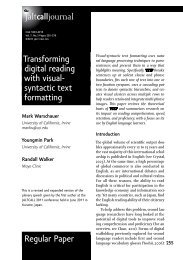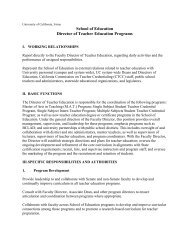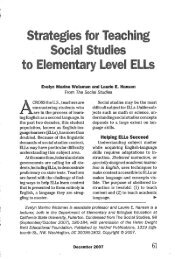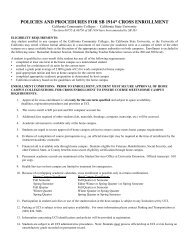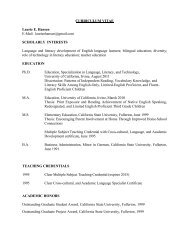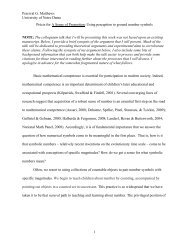POSITIVE AND NEGATIVE AFFECT SCHEDULE (PANAS ...
POSITIVE AND NEGATIVE AFFECT SCHEDULE (PANAS ...
POSITIVE AND NEGATIVE AFFECT SCHEDULE (PANAS ...
You also want an ePaper? Increase the reach of your titles
YUMPU automatically turns print PDFs into web optimized ePapers that Google loves.
NICHD SECCYD—Wisconsin<br />
<strong>POSITIVE</strong> <strong>AND</strong> <strong>NEGATIVE</strong> <strong>AFFECT</strong> <strong>SCHEDULE</strong> (<strong>PANAS</strong>)<br />
Reference<br />
Watson, D., Clark, L. A., & Tellegen, A. (1988). Development and validation of brief measures<br />
of positive and negative affect: The <strong>PANAS</strong> scales. Journal of Personality and Social<br />
Psychology, 54(6), 1063-1070.<br />
Description<br />
The 20-item Positive and Negative Affect Schedule (<strong>PANAS</strong>), developed with a sample of<br />
undergraduate students and validated with adult populations, comprises two mood scales, one<br />
measuring positive affect and the other measuring negative affect. Each item is rated on a 5-point<br />
scale ranging from 1 = very slightly or not at all to 5 = extremely to indicate the extent to which<br />
the respondent has felt this way in the indicated time frame. The authors have used the scale to<br />
measure affect at this moment, today, the past few days, the past week, the past few weeks, the<br />
past year, and generally (on average).<br />
Watson et al. (1988) reported Cronbach’s alpha coefficients for the various time reference<br />
periods ranging from .86 to .90 for the Positive Affect scale and .84 to .87 for the Negative<br />
Affect scale. For the general period, alpha was .88 for Positive Affect and .87 for Negative<br />
Affect. Test-retest correlations for an 8-week period ranged from .47 to .68 for Positive Affect,<br />
.39 to .71 for Negative Affect (for the general time period, Positive Affect stability = .68,<br />
Negative Affect Stability = .71). The scale authors also reported evidence for the validity of the<br />
<strong>PANAS</strong>: Measures of general distress and dysfunction, depression, and state anxiety are more<br />
highly correlated with the Negative Affect scale (positive correlations) than the Positive Affect<br />
scale (negative correlations).<br />
Administration: 54 months, Grade 1<br />
Child’s affect: The version of the <strong>PANAS</strong> assessing the child’s affect generally was administered<br />
to mothers at 54 months (n = 90) during the common protocol lab visit, and at Grade 1 to<br />
mothers (n = 99) and fathers/partners (n = 74) during a site-specific home visit.<br />
Own affect: The version of the <strong>PANAS</strong> that measures the respondent’s affect generally was<br />
administered at Grade 1 to mothers (n = 99) and fathers/partners (n = 74) during a site-specific<br />
home visit.<br />
Scoring: Watson et al. (1988)<br />
Positive Affect<br />
Sum of 10 items: 1, 3, 5, 9, 10, 12, 14, 16, 17, 19. In cases with internally missing data (items not<br />
answered), the sums were computed after imputation of the missing values: # items on scale / #<br />
actually answered, multiplied by the sum obtained from the answered items. A higher score<br />
indicates more positive affect, or the extent to which the individual feels enthusiastic, active, and<br />
alert.<br />
Mother report, child positive affect, 54 months = M54PANCP<br />
N = 90, M = 39.19, SD = 4.54, range = 27-49, α = .79<br />
Mother report, child positive affect, Grade 1 = MG1PANCP<br />
N = 99, M = 39.94, SD = 5.13, range = 25-50, α = .84<br />
1 of 2
NICHD SECCYD—Wisconsin<br />
Father/partner report, child positive affect, Grade 1 = FG1PANCP<br />
N = 74, M = 39.74, SD = 5.28, range = 22-49, α = .88<br />
Mother report, own (self) positive affect, Grade 1 = MG1PANSP<br />
N = 99, M = 36.75, SD = 5.51, range = 24-48, α = .85<br />
Father/partner report, own (self) positive affect, Grade 1 = FG1PANSP<br />
N = 74, M = 36.32, SD = 5.46, range = 24-50, α = .89<br />
Negative Affect<br />
Sum of 10 items: 2, 4, 6, 7, 8, 11, 13, 15, 18, 20. A higher score indicates more negative affect,<br />
or the extent to which the individual feels aversive mood states and general distress. In cases<br />
with internally missing data (items not answered), the sums were computed after imputation of<br />
the missing values. The imputed score = # items on scale/# actually answered, multiplied by the<br />
sum obtained from the answered items.<br />
Mother report, child negative affect, 54 months = M54PANCN<br />
N = 90, M = 16.97, SD = 4.25, range = 10-30, α = .78<br />
Mother report, child negative affect, Grade 1 = MG1PANCN<br />
N = 99, M = 16.52, SD = 5.62, range = 10-39, α = .89<br />
Father/partner report, child negative affect, Grade 1 = FG1PANCN<br />
N = 74, M = 18.45, SD = 5.62, range = 10-33, α = .90<br />
Mother report, own (self) negative affect, Grade 1 = MG1PANSN<br />
N = 99, M = 16.85, SD = 5.21, range = 10-33, α = .86<br />
Father/partner report, own (self) negative affect, Grade 1 = FG1PANSN<br />
N = 74, M = 17.77, SD = 5.91, range = 10-32, α = .90<br />
Analysis Data Sets<br />
54 months: SS54MO<br />
Grade 1: SSG1<br />
Raw Data Sets<br />
Mother report of child’s affect, 54 months: M54PAN<br />
Mother report of child’s affect, Grade 1: M1GPAN<br />
Father/partner report of child’s affect, Grade 1: F1GPAN<br />
Mother report of own affect, Grade 1: M1GPANS<br />
Father/partner report of own affect, Grade 1: F1GPANS<br />
2 of 2



